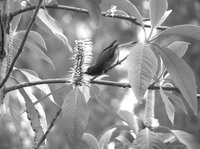近日,中科院昆明植物所的科研人员通过对唇形科木本植物米团花进行研究,在米团花有色花蜜中分离出一种紫色花青素,并首次在天然花蜜中报道此种化合物,确认它在引起花蜜产生颜色过程中所起到的关键作用。该研究成果已发表在国际著名杂志《新植物学家》上。

图为蓝翅希鹛在传粉。供图:中科院昆明植物研究所张凤萍
自然界中绝大多数花蜜是无色液体,目前全世界已知的有色花蜜植物仅有68种,绝大多数分布于南半球热带和亚热带地区,此前几乎没有关于引起花蜜着色的化学物质、生态学功能和机制的研究报道。
据介绍,米团花为中国—喜马拉雅地区已知的唯一呈现有色花蜜的植物。该团队对米团花的传粉与化学生态学开展了深入的研究。研究组成员张凤萍说:“我们还发现米团花通过花蜜的色彩和动态变化来吸引鸟类传粉者,影响它们的行为,即通过花在不同发育阶段中花蜜的‘可口性’及花蜜分泌量变化和颜色呈现作为精确的取食信号,在取食花蜜过程中有效地提高了传粉效率。”
《新植物学家》主编和审稿专家认为,该研究对有色花蜜的生态功能和机制研究具有非常高的科学价值,为进行花蜜着色对有效传粉者的视觉吸引、取食信号及其进化意义的研究开辟了一个崭新途径。
相关英文论文摘要:
Dark purple nectar as a foraging signal in a bird‐pollinated Himalayan plant
Some plants secrete coloured nectar to attract pollinators, but little is known about the chemical origins of nectar colouration and its ecological function. Leucosceptrum canum stands out as the only plant with coloured nectar recorded in the Himalayas. Here, we focused on the compound associated with the dark colour of the nectar, as well as its secretion dynamics during the flowering season and its relationship to pollinators.•Fresh nectar was analysed by semi-preparative reversed-phase high-performance liquid chromatography (HPLC), LC-MS and HRESIMS (high resolution electronspray ionization mass spectroscopy) to determine which compound causes the nectar colouration. Behavioural experiments were conducted with birds and honeybees to elucidate the effect of the nectar colour and volume on pollinators.•We identified a purple anthocyanidin, 5-hydroxyflavylium, as a natural nectar product for the first time. Two short-billed birds were found to pollinate this plant, which employs two nectar-based mechanisms to direct bird pollinators to reproductively active flowers, controlling nectar palatability and presenting a foraging signal for birds by altering nectar volume and colour in a developmental stage-specific manner.•5-Hydroxyflavylium was found to be the cause of the nectar colouration, the function of which is to act as a foraging signal to increase pollination efficiency through nectar visibility and palatability.
英文论文链接:https://onlinelibrary.wiley.com/doi/10.1111/j.1469-8137.2011.03894.x/abstract







